| Columns Retired Columns & Blogs |
Aesthetix Saturn Calypso line preamplifier Measurements
Sidebar 3: Measurements
As supplied for review—some internal jumpers are present on each channel's printed circuit board, but I have no idea what they change—the Saturn Calypso offered very high gain with its volume control set to its maximum (an indicated "88" on the display): 33.3dB from the balanced jacks, and 6dB less, as expected, from the unbalanced jacks. The unity-gain setting of the volume control in balanced mode was "55." Both balanced and unbalanced operation preserved absolute polarity—ie, the preamp was noninverting—with the front-panel switch set to noninverting; the XLR jacks appear to be wired with pin 2 "hot." The balanced input impedance was a high 41k ohms across the audioband; the unbalanced input impedance was half this figure, at 20k ohms, which is still usefully high.
The Calypso's output impedance was very different from the balanced and unbalanced outputs, suggesting that the former have an additional buffer stage (though no suitable solid-state devices can be seen on each channel's circuit board). The balanced output impedance was 112 ohms at 1kHz and above, this increasing to 3900 ohms at 20Hz due to the finite physical size of the output coupling capacitors. The unbalanced output impedance was a high 2400 ohms at midrange and high frequencies, rising slightly to 3150 ohms at 20Hz. In unbalanced mode, the Calypso will need to be used with a power amplifier offering an input impedance of at least 30k ohms if the bass is not to sound lean. Fortunately, Michael Fremer's Musical Fidelity kW amplifier has an unbalanced input impedance of 230k ohms, so he would not have had any problems in that respect.
As a result of the difference between the balanced output's source impedance at low and high frequencies, the Calypso's response into 600 ohms will be drastically rolled off below the middle of the midrange (fig.1, bottom trace below 1kHz). Into the more realistic 100k ohm load, however, the Aesthetix preamp's output is flat down to below the audioband. At the other end of the spectrum, the balanced output has a wide bandwidth, the ultrasonic –3dB point lying at 150kHz. This figure was taken with the volume control at its maximum; it decreases slightly at lower volume-control settings. It also decreases significantly from the unbalanced jacks, to 53kHz, which results in an output down by 0.75dB at 20kHz (fig.1, bottom traces above 5kHz).
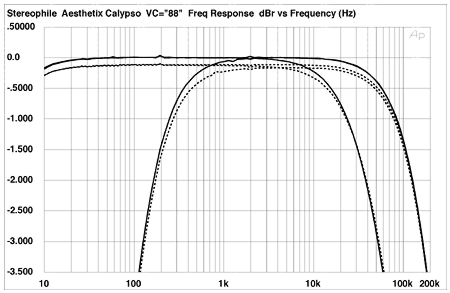
Fig.1 Aesthetix Saturn Calypso, balanced frequency response at 1V output into 100k ohms (top) and 600 ohms (bottom below 1kHz), and unbalanced frequency response at 1V into 100k ohms (bottom above 5kHz). (0.5dB/vertical div., right channel dashed.)
With its dual-mono construction, the Calypso's channel separation was excellent (not shown). Its signal/noise ratio was less good, however, at 50.25dB, unweighted wideband (ref. 1V output with the input shorted and the volume control at its maximum). This compromised figure was due to some RF breakthrough present on the preamp's output: a discrete tone was present at a frequency of 519kHz, with an absolute level of 5mV. I could not get rid of this tone, no matter how I arranged the grounding between the Calypso and the Audio Precision test set. It stubbornly refused to disappear even when I directly connected the preamp's chassis ground to the test set's chassis ground. Reducing the measurement bandwidth eliminated the effect of this tone on the measurement, however, and increased the S/N ratio to 78.8dB. A-weighted, the ratio was a good 87.3dB.
The Calypso was capable of enormous voltage swings. Fig.2 plots the percentage of THD+noise in its balanced output against output voltage into 100k ohms (right) and 600 ohms (left). No fewer than 65V are available at clipping (defined as 1% THD+N) into 100k ohms! However, the distortion starts to rise above 2V, which is about the highest the Calypso will be asked to deliver under real-world conditions. Even into the demanding 600 ohm load, the Calypso would swing 10V RMS from its balanced output. The unbalanced output delivered up to 30V into 100k ohms (fig.3). However, its output capability fell off rapidly as the load decreased, with 5.3V available into 10k ohms but just 600mV into 1k ohm.
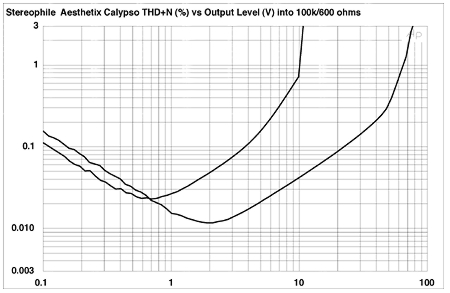
Fig.2 Aesthetix Saturn Calypso, balanced operation, distortion (%) vs 1kHz output voltage into (from bottom to top at 10V): 100k ohms, 600 ohms.
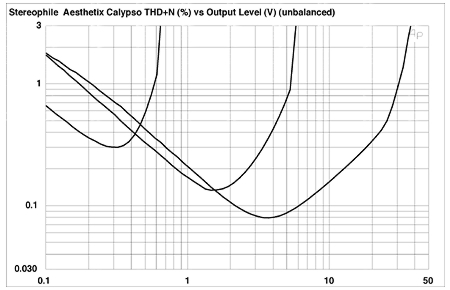
Fig.3 Aesthetix Saturn Calypso, unbalanced operation, distortion (%) vs 1kHz output voltage into (from bottom to top): 100k ohms, 10k ohms, 1k ohm.
With the levels and load impedance the Calypso will be working with, its distortion from either set of outputs is low. Fig.4, for example, plots the THD+noise percentage against frequency at 2V from the balanced outputs into 100k and 600 ohms. Even into 600 ohms, the THD+N remains at or below 0.05% from the worst, left, channel, while with the unbalanced output driving 1V into 8k ohms—a load well below what I would recommend—the THD measured 0.078% (true sum of the harmonics), the second, third, and fourth harmonics linearly decreasing in level with increasing order (fig.5). The latter is always musically consonant behavior, particularly as there are no higher-order harmonics evident in this graph.
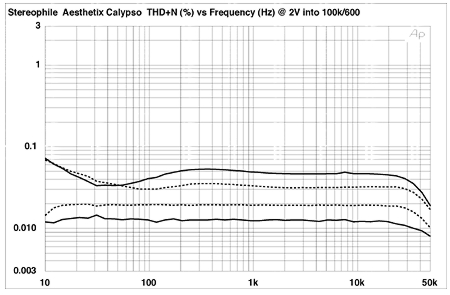
Fig.4 Aesthetix Saturn Calypso, balanced, THD+N (%) vs frequency at 2V into (from bottom to top): 100k ohms, 600 ohms (right channel dashed).
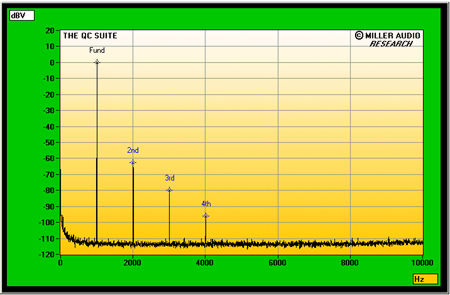
Fig.5 Aesthetix Saturn Calypso, unbalanced spectrum of 1kHz sinewave, DC–10kHz, at 1V into 8k ohms (linear frequency scale).
Both balanced (not shown) and unbalanced outputs (fig.6) featured relatively low levels of intermodulation distortion, the 1kHz difference component, resulting from the preamp driving an equal mix of 19kHz and 20kHz tones at 1V into 8k ohms, lying at –75dB.
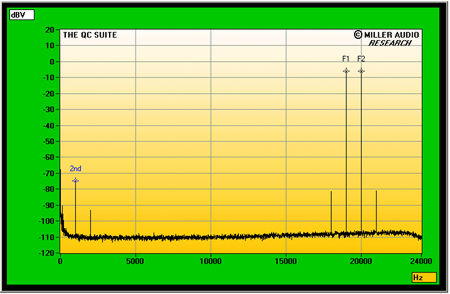
Fig.6 Aesthetix Saturn Calypso, unbalanced HF intermodulation spectrum, DC–24kHz, 19+20kHz at 1V into 8k ohms (linear frequency scale).
While there were some aspects of the Aesthetix Saturn Calypso's measured performance that concerned me—that RF noise on its output, for example—and others will mandate that care be taken with component matching, overall, this is a well-engineered preamplifier.—John Atkinson
- Log in or register to post comments




































